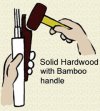- Joined
- Oct 11, 2012
- Messages
- 196
Long story short I traded a friend something and he gave me his Katana a friend gave him years ago. I thought it was gonna be some Chinese knockoff like most of the ones you see but I really think I got something here..
The first thing I noticed was how heavy it was and the weight of it. It was super sharp to my suprise. The blade collar and "Seppa" I think it is called is all solid steel. I tried to tap the pegs out of the Tsuka but I only found 1 peg to tap out so I wasn't able to take it off to look at the tang. The sheath holds it very tightly and from the scratch and ding marks in it you can tell its a solid piece of wood.
The only information I can give to help Identify this is how "solid" it feels. There is no play in it and it is super sharp and heavy. It don't feel like a cheap sword. I mainly collect knives so i really don't know a lot about swords. I appreciate any help!







The first thing I noticed was how heavy it was and the weight of it. It was super sharp to my suprise. The blade collar and "Seppa" I think it is called is all solid steel. I tried to tap the pegs out of the Tsuka but I only found 1 peg to tap out so I wasn't able to take it off to look at the tang. The sheath holds it very tightly and from the scratch and ding marks in it you can tell its a solid piece of wood.
The only information I can give to help Identify this is how "solid" it feels. There is no play in it and it is super sharp and heavy. It don't feel like a cheap sword. I mainly collect knives so i really don't know a lot about swords. I appreciate any help!








